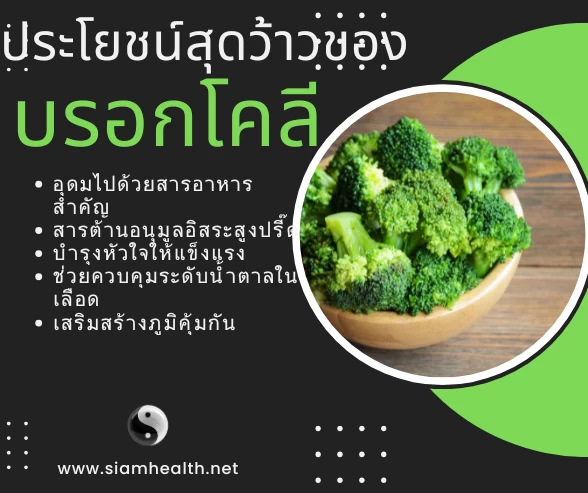
หน้าหลัก | สุขภาพดี | สุภาพสตรี | การแปลผลเลือด | โรคต่างๆ | ยารักษาโรค |วัคซีน | อาหารเพื่อสุขภาพ
ประโยชน์สุดว้าวของบรอกโคลี: ทำไมคุณควรเพิ่มมันในมื้ออาหาร!
ในบรรดาผักสีเขียวทั้งหมด บรอกโคลี (Broccoli) คือหนึ่งในซูเปอร์สตาร์ที่อุดมไปด้วยสารอาหารและมีประโยชน์ต่อสุขภาพอย่างน่าทึ่ง ไม่ใช่แค่เป็นเครื่องเคียงที่เพิ่มสีสันให้กับจานอาหาร แต่บรอกโคลียังเป็นขุมทรัพย์ทางโภชนาการที่พร้อมจะช่วยดูแลร่างกายของคุณในหลายๆ ด้าน มาดูกันว่าทำไมบรอกโคลีถึงเป็นผักที่คุณไม่ควรมองข้าม
1. อุดมไปด้วยสารอาหารสำคัญ
บรอกโคลีเป็นแหล่งรวมของวิตามินและแร่ธาตุที่จำเป็นต่อร่างกาย ไม่ว่าจะเป็น:
-
วิตามินซี: สูงมากในบรอกโคลี ซึ่งเป็นสารต้านอนุมูลอิสระที่ช่วยเสริมสร้างภูมิคุ้มกันของร่างกาย ป้องกันหวัด และช่วยในการดูดซึมธาตุเหล็ก
-
วิตามินเค: จำเป็นต่อการแข็งตัวของเลือดและช่วยบำรุงกระดูกให้แข็งแรง
-
โฟเลต (วิตามินบี 9): สำคัญต่อการสร้างเซลล์ใหม่ และมีความสำคัญเป็นพิเศษสำหรับหญิงตั้งครรภ์
-
โพแทสเซียม: ช่วยควบคุมสมดุลของเหลวในร่างกายและรักษาระดับความดันโลหิตให้ปกติ
-
ใยอาหาร: สูงมาก ช่วยในการขับถ่าย ป้องกันท้องผูก และรักษาสมดุลของระบบย่อยอาหาร

2. สารต้านอนุมูลอิสระสูงปรี๊ด
บรอกโคลีเต็มไปด้วยสารต้านอนุมูลอิสระหลากหลายชนิด เช่น สารประกอบซัลโฟราเฟน (Sulforaphane), อินโดล-3-คาร์บินอล (Indole-3-Carbinol), และกลูโคราฟานิน (Glucoraphanin) สารเหล่านี้มีบทบาทสำคัญในการต่อสู้กับอนุมูลอิสระในร่างกาย ซึ่งเป็นสาเหตุของการอักเสบ ความเสียหายของเซลล์ และอาจนำไปสู่โรคเรื้อรังต่างๆ รวมถึงโรคมะเร็งบางชนิด การบริโภคบรอกโคลีเป็นประจำจึงอาจช่วยลดความเสี่ยงเหล่านี้ได้
3. บำรุงหัวใจให้แข็งแรง
ด้วยใยอาหาร โพแทสเซียม และสารต้านอนุมูลอิสระต่างๆ บรอกโคลีจึงมีส่วนช่วยในการดูแลสุขภาพหัวใจและหลอดเลือด ใยอาหารช่วยลดระดับคอเลสเตอรอลชนิดไม่ดี (LDL) ในขณะที่โพแทสเซียมช่วยควบคุมความดันโลหิต และสารต้านอนุมูลอิสระช่วยลดการอักเสบในหลอดเลือด ทำให้ระบบไหลเวียนโลหิตทำงานได้อย่างมีประสิทธิภาพ
4. ช่วยควบคุมระดับน้ำตาลในเลือด
สำหรับผู้ที่มีความเสี่ยงเป็นโรคเบาหวานหรือผู้ป่วยเบาหวาน บรอกโคลีเป็นตัวเลือกที่ดีเยี่ยมเนื่องจากมีใยอาหารสูงและมีค่าดัชนีน้ำตาลต่ำ ใยอาหารช่วยชะลอการดูดซึมน้ำตาลเข้าสู่กระแสเลือด ทำให้ระดับน้ำตาลคงที่ ไม่พุ่งสูงขึ้นอย่างรวดเร็ว
5. เสริมสร้างภูมิคุ้มกัน
วิตามินซีที่อุดมอยู่ในบรอกโคลีเป็นกุญแจสำคัญในการเสริมสร้างระบบภูมิคุ้มกันให้แข็งแรง ช่วยให้ร่างกายสามารถต่อสู้กับเชื้อโรคต่างๆ ได้ดีขึ้น และลดความถี่ในการเจ็บป่วย
เคล็ดลับการกินบรอกโคลีให้อร่อยและได้ประโยชน์สูงสุด
เพื่อให้ได้ประโยชน์จากบรอกโคลีสูงสุด ควรเลือกวิธีการปรุงที่เหมาะสม เช่น:
-
นึ่ง: เป็นวิธีที่ดีที่สุดในการคงคุณค่าทางโภชนาการ
-
ลวก: ไม่ควรลวกนานเกินไป เพราะวิตามินบางชนิดอาจสลายไปกับความร้อน
-
ผัด: ผัดกับน้ำมันน้อยๆ หรือน้ำสต็อก เพื่อลดปริมาณไขมัน
บรอกโคลีสามารถนำไปประกอบอาหารได้หลากหลายเมนู ไม่ว่าจะเป็นสลัด ผัดผัก ซุป หรือเป็นเครื่องเคียงคู่กับเมนูโปรดของคุณ อย่ารอช้า! ลองเพิ่มบรอกโคลีเข้าไปในมื้ออาหารของคุณดูสิ แล้วคุณจะสัมผัสได้ถึงพลังงานและความสดชื่นที่มาจากผักสีเขียวมหัศจรรย์นี้
ตัวอย่างเมนูอาหารที่ทำจาก บรอกโคลี่
เพิ่มบรอกโคลีเข้าไปในมื้ออาหารเพื่อสุขภาพ ลองสองเมนูนี้ดูนะคะ ทำง่าย อร่อย และได้ประโยชน์เต็มๆ
1. สลัดบรอกโคลีอกไก่นึ่งย่าง (Broccoli & Grilled Chicken Salad)
เมนูนี้เหมาะสำหรับมื้อเบาๆ ที่ต้องการโปรตีนและใยอาหารครบถ้วน ได้ความสดชื่นจากผัก และรสชาติกลมกล่อมจากน้ำสลัด
ส่วนประกอบ:
-
บรอกโคลี: 1 ถ้วย (หั่นพอดีคำ นำไปนึ่งหรือลวกพอสุกแต่ยังคงความกรอบ)
-
อกไก่: 1 ชิ้น (ประมาณ 100-150 กรัม นำไปหมักเกลือ พริกไทย และสมุนไพรเล็กน้อย จากนั้นย่างหรืออบจนสุก หั่นเป็นชิ้นพอดีคำ)
-
ผักสลัดคละชนิด: เช่น กรีนโอ๊ค เรดโอ๊ค คอส ตามชอบ 1 ถ้วย
-
มะเขือเทศเชอร์รี่: ผ่าครึ่ง 5-6 ลูก
-
หอมแดง: ซอยละเอียด 1 ช้อนโต๊ะ (ไม่ใส่ก็ได้ถ้าไม่ชอบ)
-
เมล็ดทานตะวัน หรือ อัลมอนด์สไลด์: เล็กน้อย (สำหรับเพิ่มความกรอบและไขมันดี)
ส่วนประกอบน้ำสลัด (แบบง่ายๆ สุขภาพดี):
-
น้ำมันมะกอก: 2 ช้อนโต๊ะ
-
น้ำมะนาว: 1 ช้อนโต๊ะ
-
น้ำผึ้ง หรือ หญ้าหวาน: 1 ช้อนชา (ปรับตามชอบ)
-
เกลือ พริกไทย: เล็กน้อย
-
มัสตาร์ด (ถ้ามี): 1 ช้อนชา (เพิ่มรสชาติ)
วิธีทำ:
-
นำบรอกโคลีที่เตรียมไว้ ผักสลัด มะเขือเทศ และอกไก่ที่หั่นแล้วใส่ลงในชามผสม
-
ผสมส่วนประกอบน้ำสลัดทั้งหมดให้เข้ากัน ชิมรสตามชอบ
-
เทน้ำสลัดราดลงบนส่วนผสมสลัด คลุกเคล้าเบาๆ ให้เข้ากัน
-
โรยด้วยเมล็ดทานตะวันหรืออัลมอนด์สไลด์ พร้อมเสิร์ฟ
2. บรอกโคลีผัดกระเทียมน้ำมันหอย (Stir-fried Broccoli with Garlic and Oyster Sauce)
เมนูคลาสสิกที่ทำง่าย อร่อย และได้ประโยชน์จากบรอกโคลีเต็มๆ เหมาะสำหรับทานคู่กับข้าวสวยร้อนๆ หรือเป็นเครื่องเคียงสำหรับเมนูโปรดของคุณ
ส่วนประกอบ:
-
บรอกโคลี: 1 หัวกลาง (หั่นเป็นช่อพอดีคำ นำไปลวกในน้ำเดือดที่ผสมเกลือเล็กน้อย ประมาณ 1-2 นาที แล้วรีบตักแช่น้ำเย็นจัด เพื่อคงความเขียวสดและกรอบ)
-
กระเทียม: สับละเอียด 3-4 กลีบ
-
น้ำมันหอย: 1-2 ช้อนโต๊ะ (ปรับตามชอบ)
-
ซีอิ๊วขาว: 1 ช้อนชา
-
น้ำตาลทราย: 1/2 ช้อนชา (ไม่ใส่ก็ได้)
-
น้ำเปล่า หรือ น้ำสต็อก: 2-3 ช้อนโต๊ะ
-
น้ำมันสำหรับผัด: 1 ช้อนโต๊ะ
วิธีทำ:
-
ตั้งกระทะ ใส่น้ำมันเล็กน้อย ใช้ไฟปานกลาง
-
ใส่กระเทียมสับลงไปเจียวจนหอมเหลือง
-
ใส่บรอกโคลีที่ลวกเตรียมไว้ลงไปผัดอย่างรวดเร็ว
-
ปรุงรสด้วยน้ำมันหอย ซีอิ๊วขาว และน้ำตาลทราย ผัดให้เข้ากัน
-
เติมน้ำเปล่าหรือน้ำสต็อกเล็กน้อย เพื่อให้มีน้ำซอสคลุกคลิก
-
ผัดให้เข้ากันอีกครั้ง ปิดไฟ ตักใส่จาน พร้อมเสิร์ฟ
หวังว่าสองเมนูนี้จะเป็นแรงบันดาลใจให้คุณสนุกกับการทำอาหารจากบรอกโคลีนะคะ
